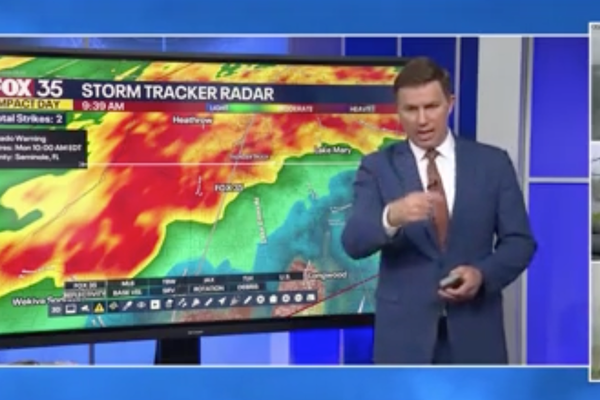
Temperatures have soared above 30C for the first time this year – and meteorologists forecast the chance of Britain experiencing a hot summer is now 45% – 2.3 times the normal figure.
The warning leaves the nation braced for a possible repeat of last year’s record-breaking heatwave which triggered wildfires, disrupted rail transport, closed schools, led to thousands of premature deaths and saw temperatures break the 40C record in the UK for the first time.
Whether Britain will again experience a breach of the 40C level remains unclear, however. “There’s no strong indications for it,” said Mark Bevan, a senior Met Office adviser. “On the other hand, we saw it last year, so it’s obviously inherently possible. So never say never.”
Bevan said the coming summer’s weather prospects had been calculated using a number of factors including the El Niño effect, wind patterns and sea surface temperatures: “If the wind comes predominantly from the north, that would cool the weather. If the sea surface temperature is high, that acts a bit like an electric blanket for the country.”
Based on these factors, forecasters say there is a 5% chance the weather will be cool this summer and a 45% chance it will be hot, the latter figure being 2.3 times higher than normal.
Even if Britain does not experience 40C temperatures this year, it is clear there will be increasing numbers of heatwaves in the near future, with damaging consequences. At temperatures of over 35C even healthy people suffer effects, especially those who have to work outdoors. For the elderly and those living with respiratory or cardiovascular conditions, the impact is worse.
A joint report by the Office for National Statistics and the UK Health Security Agency revealed that last year there had been 3,000 more deaths in England and Wales than would usually be expected in the summer. Crucially most extra deaths occurred in the over-65s and during the heatwave’s hottest days in late July.
Night temperatures pose an additional problem, added Bevan. “If you get very hot days but cool evenings, people can recover a bit. But if the temperature never dips below 20C at night, that becomes a real problem.”

Forest fires are another concern, with outbreaks already causing devastation this year. Half of the RSPB’s Corrimony nature reserve near Loch Ness was destroyed by a massive blaze earlier this month. “I should be seeing black grouse and curlew chicks emerging from their nests now but there is just charred landscape,” said site manager Simon McLaughlin. “Other wildlife such as adders, lizards and frogs had no time to escape either. It will take hundreds of thousands of pounds to restore this habitat.”
Bevan summed up the national situation: “Last year was the UK’s warmest on record and that has really focused everybody’s attention on the impact of heat. The 2022 heatwave disrupted transport, the emergency services, power supplies and people’s health and we now realise these are impacts that will have to be dealt with regularly in coming years,” he said.
The prime driver of this meteorological chaos is carbon dioxide, a heat-trapping gas that is being pumped into the atmosphere by cars, factories and power plants at increasing rates. Between 1960 and 1970 carbon dioxide levels grew at a rate of around 1 part per million (ppm). Now, they are rising by about 2.37ppm per year. In 1965, carbon dioxide levels were 320ppm. This year they have topped 420ppm.
At this rate, the world will soon have heated by more than 1.5C since pre-industrial levels, a temperature that was supposed to be the upper acceptable limit for global warming. In fact, the world could heat by almost 3C by the end of the century, triggering the melting of ice caps, the death of coral reefs and rising ocean levels.
For its part, Britain will experience weather patterns that will become increasingly grim, a point stressed by a study published last week by an international team led by Bath University researchers. It predicts that peak summer temperatures of 41C and weekly averages of 28C will be normal in large parts of southern England towards the end of the century. These figures compare with maximum peaks of 31C and averages of 20C that occurred in the 1970s.
Temperature rises on this scale emphasise the urgent need to make radical changes in infrastructure and underline the problems facing the UK, said Prof David Coley of Bath University. “The average temperature difference between London and Nice is only 5C – but those two places are totally different in terms of how people live, the plants around them, the buildings they create and how prepared they are for heatwaves,” he said.
This point was backed by Bob Ward, the policy director at the Grantham Research Institute on Climate Change. “It is clear that the UK is dangerously unprepared for the growing intensity and frequency of heatwaves, which are damaging lives and livelihoods across the country.
“The government is due to publish imminently a new plan for adapting the country to the impacts of climate change. It absolutely must include a national heat risk strategy that focuses on preventing overheating in buildings rather than just dealing with the health consequences of homes that become deathtraps in hot weather.”




![Nevada Math Prof Alleges Discipline for "Voic[ing] Concerns About … the Math Department … Lower[ing] Its Curriculum Standards"](https://images.inkl.com/s3/publisher/cover/212/reason-cover.png?w=600)


